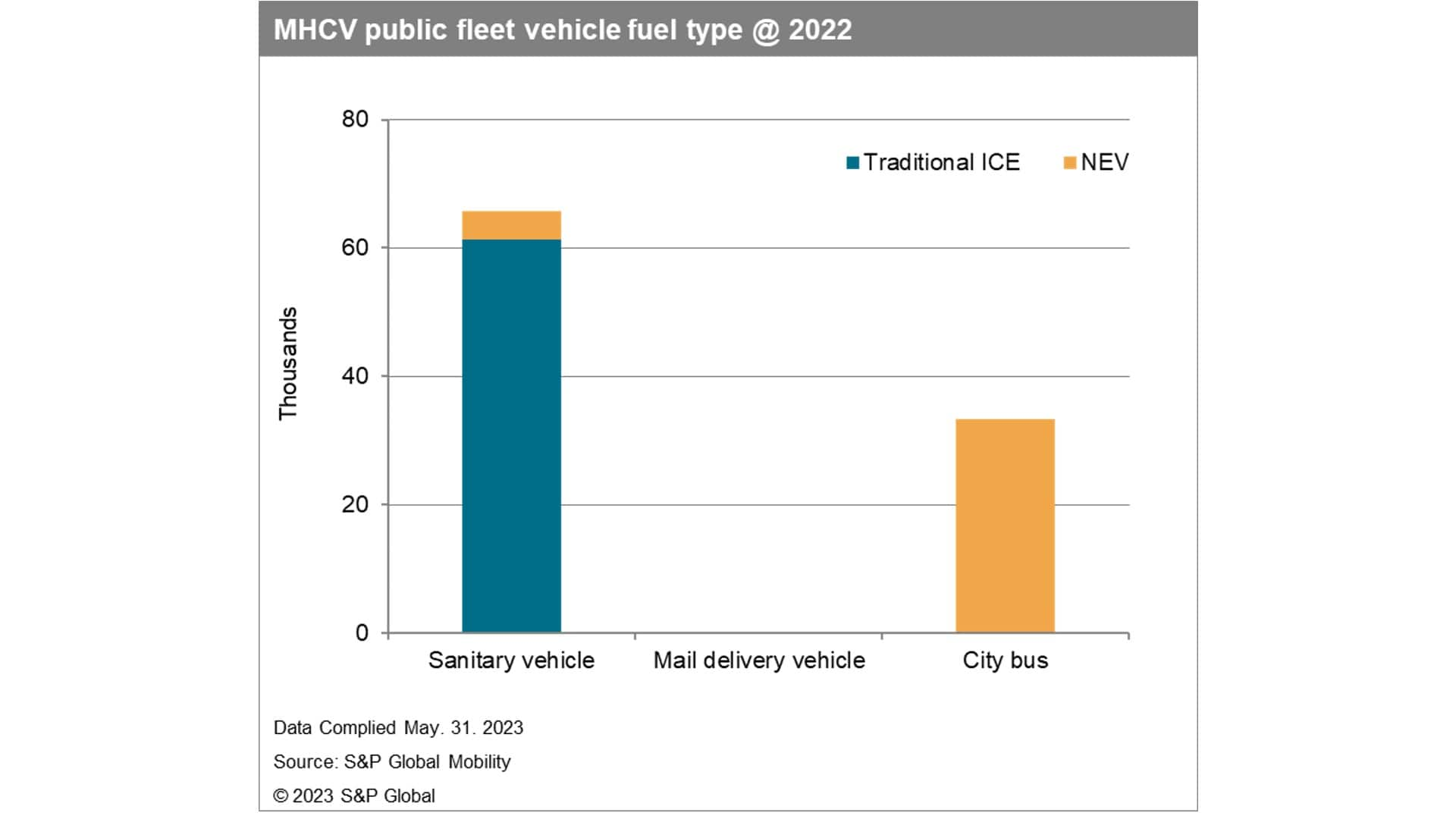Discover more about S&P Global's offerings
Customer Logins
Obtain the data you need to make the most informed decisions by accessing our extensive portfolio of information, analytics, and expertise. Sign in to the product or service center of your choice.
Customer Logins
BLOG
Sep 04, 2023
The challenge of greening mainland China's garbage-truck fleet
Local government financial challenges may blunt mainland China central government efforts to accelerate public fleet electrification, especially concerning sanitation vehicles.
In February 2022, eight departments of the Chinese central government jointly launched a pilot city program for the comprehensive electrification of public fleet vehicles throughout the country - with a timeline lasting from 2023 to 2025.
But recent signs show progress could be slow, as local governments are caught between pressure from existing national targets and reduced direct electrification subsidy support from the central government.
This pilot program is a concrete measure taken by the central government to achieve the country's goals for New Energy Vehicles (battery-electric vehicles, plug-in hybrid vehicles and fuel-cell electric vehicles), as outlined at the beginning of the 14th Five-Year Plan. But a 12-year NEV subsidy ended last year, and the 2023 pilot program will not provide direct-finance subsidies.
The pilot program aims to achieve a proportion of 80% of NEV for newly purchased public fleet vehicles in the pilot cities. Public fleet vehicles
include government vehicles, city buses, sanitation vehicles, taxis, mail delivery vehicles, urban logistic and distribution vehicles, and airport vehicles.
In addition, the notice also puts forward specific targets for the NEV charging service facilities in pilot cities. Pilot cities are also required to explore NEV's new technologies and new business models.
Among public sector vehicles, the most often used medium and heavy commercial vehicles are sanitation vehicles (66%), city buses (33%), and mail delivery vehicles (~1%). But in 2022, the NEV proportion of the city bus market had already reached 99.5%. Therefore, the sanitation vehicle market is the most likely to be affected by the latest notice.

Following the COVID-19 pandemic, it is likely that sanitation vehicle demand will have a purchasing rebound. However, S&P Mobility expects the rebound will be limited because of the recent shrinking in local government expenditures. In mainland China, sanitation vehicle purchasing highly relies on local government budgets, and after three years of the pandemic, local government finances are under pressure. Meanwhile, the central government has further tightened its management of local government debt.
Here's why this matters: This public fleet vehicle NEV pilot program works differently from previous NEV pilot programs. The central government will not directly provide financial subsidies, but instead will provide unspecified policy incentives to local governments. However, the NEV target proposed in this pilot program is relative rather than containing a specific volume target as per previous plans.
For local governments under budgetary stress, that means the total increase in the sanitation vehicle market and the increase in new energy vehicles may be limited. However, the pilot program will also help those pilot cities improve the NEV eco-system for public fleet vehicles - including charging facilities, which will create a better environment for the rapid development of NEV sanitary vehicles when they arrive in the future.
Looking beyond the pilot program, prospects for NEV vehicles remain bright. Outside the public fleet segment, demand for NEVs to reduce carbon emissions in other industries - especially the steel industry - is entering a rapid growth phase in the near coming year. As a result, S&P Mobility analysts continue to expect that the NEV market share in the medium-heavy duty truck market will climb and reach 3.1% and 3.9% in 2023 and 2024, respectively, and as high as 12.0% by 2030.
MEDIUM- AND HEAVY-COMMERCIAL VEHICLE MODEL FAMILY SALES FORECAST
MAINLAND CHINA COMMERCIAL TRUCK PRODUCTION STARTS 2023 WITH A POWERFUL REBOUND
MAINLAND CHINESE CONSUMERS CROSSING THE CHASM TO MAINSTREAM EV ADOPTION
MAINLAND CHINA'S BUS PRODUCTION IN THE SHADOW OF COVID-19
This article was published by S&P Global Mobility and not by S&P Global Ratings, which is a separately managed division of S&P Global.
{"items" : [
{"name":"share","enabled":true,"desc":"<strong>Share</strong>","mobdesc":"Share","options":[ {"name":"facebook","url":"https://www.facebook.com/sharer.php?u=http%3a%2f%2fstage.www.spglobal.com%2fmobility%2fen%2fresearch-analysis%2fthe-challenge-of-greening-mainland-chinas-garbage-truck-fleet-.html","enabled":true},{"name":"twitter","url":"https://twitter.com/intent/tweet?url=http%3a%2f%2fstage.www.spglobal.com%2fmobility%2fen%2fresearch-analysis%2fthe-challenge-of-greening-mainland-chinas-garbage-truck-fleet-.html&text=The+challenge+of+greening+mainland+China%27s+garbage-truck+fleet++%7c+S%26P+Global+","enabled":true},{"name":"linkedin","url":"https://www.linkedin.com/sharing/share-offsite/?url=http%3a%2f%2fstage.www.spglobal.com%2fmobility%2fen%2fresearch-analysis%2fthe-challenge-of-greening-mainland-chinas-garbage-truck-fleet-.html","enabled":true},{"name":"email","url":"?subject=The challenge of greening mainland China's garbage-truck fleet | S&P Global &body=http%3a%2f%2fstage.www.spglobal.com%2fmobility%2fen%2fresearch-analysis%2fthe-challenge-of-greening-mainland-chinas-garbage-truck-fleet-.html","enabled":true},{"name":"whatsapp","url":"https://api.whatsapp.com/send?text=The+challenge+of+greening+mainland+China%27s+garbage-truck+fleet++%7c+S%26P+Global+ http%3a%2f%2fstage.www.spglobal.com%2fmobility%2fen%2fresearch-analysis%2fthe-challenge-of-greening-mainland-chinas-garbage-truck-fleet-.html","enabled":true}]}, {"name":"rtt","enabled":true,"mobdesc":"Top"}
]}

